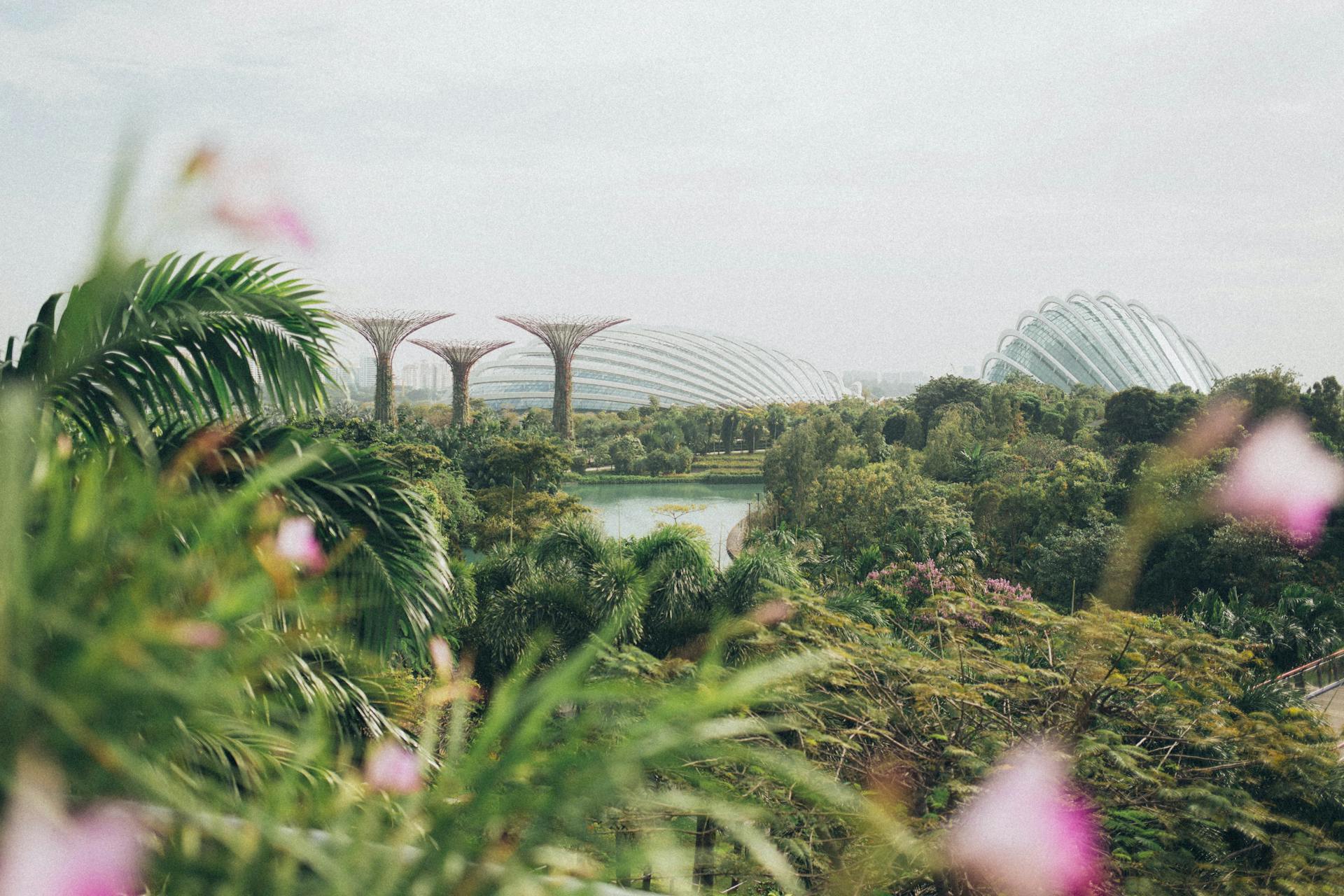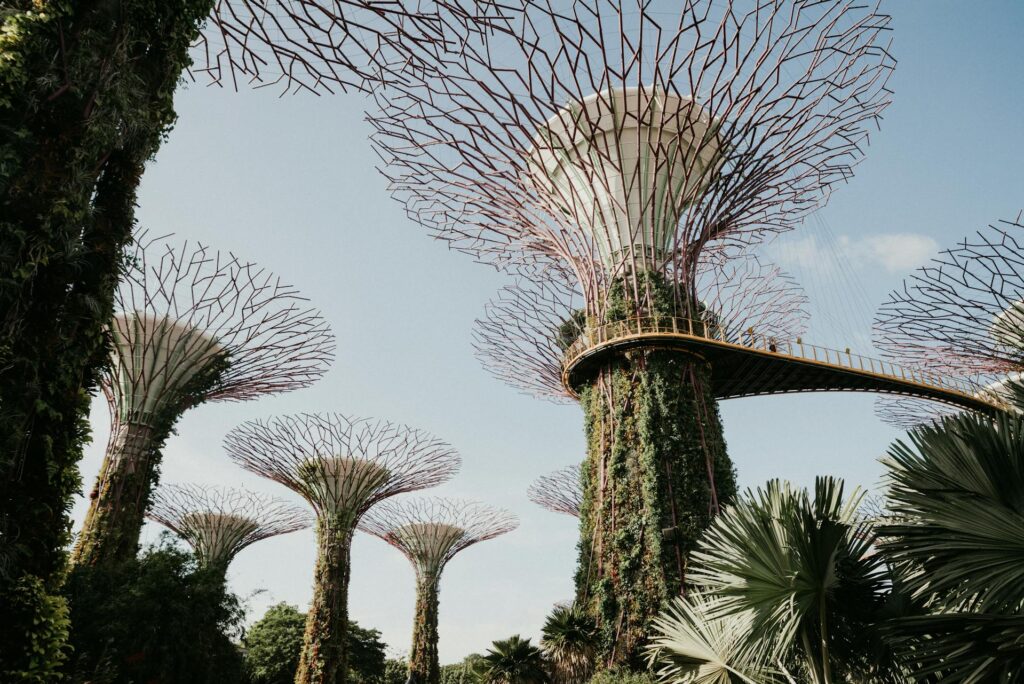Have you ever found yourself in the midst of a bustling city, craving a touch of nature? You’re not alone. Many urban dwellers long for a slice of greenery amidst the concrete jungle. The good news is, cities like Singapore are pioneering solutions that bring nature and urban life together harmoniously. Welcome to the world of Singapore green architecture, where vertical gardens are not just a trend but a vision for sustainable urban living.
The Rise of Vertical Gardens in Singapore
Singapore has long been known as the “Garden City,” but its commitment to integrating nature into urban landscapes has evolved dramatically. Vertical gardens, a key component of Singapore green architecture, are a testament to the city’s innovative approach to urban planning. These gardens, which climb the sides of skyscrapers and residential buildings, are not just aesthetically pleasing; they serve a critical purpose. By maximizing limited space, they provide a lush oasis in a densely populated city, improving air quality and reducing the urban heat island effect. The integration of vertical greenery into the urban fabric signifies Singapore’s commitment to creating a sustainable, livable city.
The concept of vertical gardens in Singapore goes beyond simply planting greenery on walls. It involves a complex interplay of architecture, horticulture, and urban planning. Architects and urban planners collaborate with botanists to select plant species that thrive in high-rise environments, ensuring these gardens are not only visually stunning but also ecologically resilient. This holistic approach to Singapore green architecture ensures that the vertical gardens are sustainable and contribute to the city’s biodiversity.
Environmental Benefits of Vertical Gardens
One of the primary benefits of vertical gardens in Singapore is their positive impact on the environment. As cities grapple with the challenges of climate change, urban heat, and air pollution, vertical gardens offer a natural solution. They act as natural air filters, absorbing pollutants and emitting oxygen, thereby improving urban air quality. This is particularly crucial in a densely populated city like Singapore, where clean air is a precious commodity. Moreover, these gardens help to cool the urban environment, reducing the need for air conditioning and lowering energy consumption.
In addition to improving air quality, vertical gardens contribute to biodiversity in urban areas. By providing habitats for various plant and animal species, they help to create a more balanced ecosystem within the city. Birds, insects, and even small mammals find refuge in these green spaces, enhancing the overall health of the urban environment. This aspect of Singapore green architecture illustrates how cities can promote environmental sustainability through innovative design.
Social and Health Benefits
Vertical gardens are not just about improving the environment; they also offer social and health benefits. In a fast-paced urban setting, access to green spaces is essential for mental well-being. Vertical gardens provide city dwellers with a visual connection to nature, which has been shown to reduce stress and promote relaxation. The presence of greenery can transform a concrete jungle into a more inviting and human-friendly space, encouraging social interactions and community engagement.
Furthermore, vertical gardens contribute to the physical health of city residents. By improving air quality and reducing urban heat, they create a healthier living environment. Studies have shown that exposure to green spaces can boost immune function and reduce the risk of respiratory illnesses. In Singapore, where space is at a premium, incorporating nature into urban living is a way to enhance quality of life without sacrificing the benefits of city living.
Economic Impacts
The economic benefits of vertical gardens are significant, making them a smart investment for cities like Singapore. By reducing energy consumption through natural cooling, vertical gardens lower utility costs for building owners and tenants. This energy efficiency translates to financial savings, which can be reinvested in other sustainable initiatives. Moreover, buildings with integrated greenery tend to have higher property values, attracting tenants and buyers who prioritize sustainability.
Additionally, vertical gardens can boost tourism and attract businesses to the city. Singapore’s reputation as a leader in green architecture draws visitors and investors interested in sustainable urban living. This influx of tourism and business contributes to the local economy, creating jobs and fostering economic growth. The integration of vertical gardens into Singapore’s urban landscape demonstrates how sustainability and economic development can go hand in hand.
The Role of Technology in Vertical Gardens
Technology plays a crucial role in the success of vertical gardens in Singapore. Advanced irrigation systems and climate control technologies ensure that these gardens thrive in the challenging urban environment. Automated watering systems deliver precise amounts of water to each plant, minimizing waste and ensuring optimal growth conditions. Sensors and smart technologies monitor the health of the plants, allowing for timely interventions to prevent disease and pests.
The use of technology in Singapore green architecture extends to the design and maintenance of vertical gardens. Computer modeling and simulation tools help architects and planners visualize how these gardens will interact with the surrounding environment, ensuring that they achieve the desired ecological and aesthetic outcomes. This integration of technology and nature is a hallmark of Singapore’s approach to sustainable urban development.

Challenges and Solutions
While the benefits of vertical gardens are clear, implementing them comes with challenges. One of the primary obstacles is the initial cost of installation and maintenance. However, Singapore has addressed this issue through government incentives and public-private partnerships. By offering grants and subsidies, the government encourages building owners to incorporate vertical gardens into their designs. These financial incentives make it feasible for more buildings to adopt this green architecture.
Another challenge is the maintenance of vertical gardens, which requires specialized knowledge and skills. Singapore has invested in training programs to develop a workforce skilled in the care and maintenance of these gardens. By building a pool of experts, the city ensures that its vertical gardens remain healthy and vibrant, maximizing their environmental and social benefits.
Case Studies: Iconic Vertical Gardens in Singapore
Several iconic buildings in Singapore exemplify the success of vertical gardens. The PARKROYAL on Pickering is a standout example, with its lush sky gardens and cascading greenery. This hotel has set a benchmark for sustainable design, seamlessly integrating nature into its architecture. Similarly, the Oasia Hotel Downtown features a striking red facade adorned with climbing plants, creating a living, breathing building that stands out in the city’s skyline.
These buildings showcase the potential of Singapore green architecture to transform urban landscapes. By prioritizing sustainability and innovation, they serve as models for other cities looking to integrate nature into their urban environments. The success of these projects demonstrates that vertical gardens are not only feasible but also desirable in modern urban planning.
Government Initiatives and Policies
The Singaporean government has played a pivotal role in promoting vertical gardens and green architecture. Through initiatives like the Green Mark Certification, the government incentivizes sustainable building practices, encouraging developers to incorporate greenery into their designs. This certification program assesses buildings based on their environmental impact, rewarding those that meet high standards of sustainability.
In addition to certification programs, the government has implemented policies that support the development of vertical gardens. Urban planning guidelines encourage the inclusion of green spaces in new developments, ensuring that future growth aligns with the city’s sustainability goals. These policies reflect Singapore’s commitment to creating a greener, more sustainable urban environment.
Community Involvement in Vertical Gardens
Community involvement is a key component of successful vertical gardens. In Singapore, residents are encouraged to participate in the care and maintenance of these gardens, fostering a sense of ownership and pride. Community gardens and urban farming initiatives have gained popularity, allowing residents to grow their own food and contribute to the city’s green spaces.
This community-driven approach to Singapore green architecture enhances social cohesion and empowers residents to take an active role in sustainability efforts. By involving the community, vertical gardens become more than just architectural features; they become integral parts of the urban lifestyle, promoting environmental stewardship and civic engagement.
Future Prospects for Green Architecture
The future of Singapore green architecture looks promising, with vertical gardens set to play an even more significant role in urban development. As technology advances and awareness of environmental issues grows, the potential for innovative green solutions will expand. Singapore’s commitment to sustainability positions it as a leader in the global movement towards greener cities.
Looking ahead, we can expect to see more creative and ambitious applications of vertical gardens. From urban farms to biodiverse ecosystems, the possibilities are endless. As cities around the world seek to balance growth with sustainability, Singapore’s model of integrating nature into urban environments offers valuable insights and inspiration.
Conclusion
Singapore’s vertical gardens are more than just architectural marvels; they represent a vision for the future of urban living. By blending nature with city life, Singapore green architecture offers a sustainable solution to the challenges faced by modern cities. With their environmental, social, and economic benefits, vertical gardens are a testament to the power of innovation and collaboration in creating livable, resilient cities. As we look to the future, Singapore’s commitment to green architecture serves as a guiding light for cities worldwide, showing that a harmonious coexistence between nature and urban life is not only possible but essential.

Recent Posts
15 Floor Plan Graphic Styles That Will Elevate Your Presentation Game
The Role of Shadows in Architectural Storytelling
When Furniture Becomes Architecture: Blurring the Line